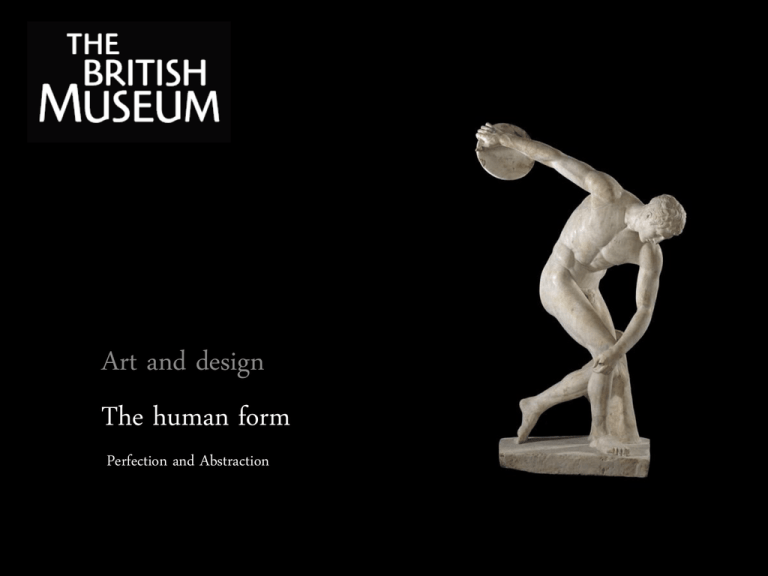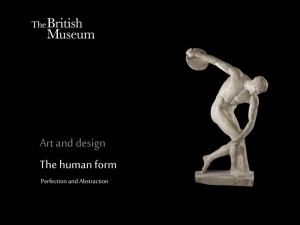mini lesson perfection and abstraction
advertisement

Art and design The human form Perfection and Abstraction We want to give a form to a god or spiritual being We want to represent ourselves We want to commemorate an ancestor We want to define our own identity We want to experiment with our bodies Why do we create objects in human form? We want to entertain We are interested in ourselves We want to portray emotions and feelings We want to communicate the power of an individual We try to understand and record unfamiliar or new peoples We want to depict the people we admire – heroes, heroines, idols We strive to create a perfect human We wish to celebrate and remember a person We want to give our children something to play with What are the basic features of the human body? head body arms legs On the right is one of the earliest examples of a representation of the human form. It is over 10,000 years old and comes from Jordan in the Middle East. It is made from lime plaster stuck onto bound reeds and twine. Even though it is simple, it is immediately recognisable as a human. The human form: art and design Perfection The ideal body All cultures have their own ideas about perfection and the ideal body. We can learn a lot about a culture and society by looking at what they thought was the ideal human form. • What are some examples of the qualities of perfection of the human form in our society? • What do these tell us about our society? • Which figures or people are represented in ideal forms? • How are these images and values spread around society? Gilded bronze figure of Tara, a Buddhist goddess Sri Lanka, 8th century AD In the Classical world (ancient Greece and Rome), there were strong and well-known ideas about what made the perfect form. These ideas were revived and spread during the Renaissance 1500 years later. Muscular and strong Symmetry and harmony in the body Michelangelo, Study for Adam, a drawing study for the ceiling of the Sistine Chapel Italy, about AD 1510-11 What similarities can you see here? Are these still considered desirable today? ‘Discus thrower, mid 5th century BC Roman copy of bronze Greek original Marble, Height: 1.7m Ideal forms in West Africa This is a brass head of a king from Ife in Nigeria, from around the 12th – 14th centuries. How would you describe this head? Is it realistic? Is it idealised? What other words can you find to describe its form? How has the face been decorated? Why is a king a good figure to examine when considering ideal forms? Ideal forms in West Africa This figure is wearing a crown and a plume. The face appears to have been enhanced with scarification – the thin vertical lines you can see were probably signs of status. The holes around the mouth may have had additional ornamentation attached, possibly a beard. Compare the realism of this head with the stylised sculptures and mosaics from Medieval Europe of a similar period. Ideas of perfection in West Africa Both scarification and body paint are used to enhance the natural human body to attain an ideal form – without it, the body is incomplete. Examine this figure from the Ekkpo society. Can you find the following? • raised facial scars • filed teeth • bracelets • black and white body painting How is strength and power suggested? The human form: art and design Abstraction Abstraction in West Africa Ideal forms vary widely from region and period in time. This is a fertility doll from the Asante people in Ghana. If an Asante woman could not have children, she would consult a priest who would give her a doll. She would carry the doll on her back, in the position a real child is carried, until she became pregnant. Which features appear important on this doll? Abstraction in West Africa Did you identify… • the broad forehead? • the prominent eyebrows? • the small mouth? • the long, ringed neck? • the breasts? • the navel? Why do you think the dolls were flat? These dolls represent ideal forms of beauty for the unborn child. In many African sculpting traditions the head is elongated to reflect its importance. Abstraction in ancient Greece The human body can be suggested very simply. • Look at this sculpture: how have the features of the body been shown? • When do you think this sculpture was made? • Are there any clues in its form to suggest why it was made? Abstraction in ancient Greece This is a sculpture from ancient Greece and is between 4000 and 5000 years old. Sculptures like this were often placed in graves. They fascinated 20th century artists who admired them for their simplicity and elegance of form. Look at the work of Henry Moore who studied and sketched in the British Museum. The inspiration he found in the British Museum was critical in his development of monumental sculptures which are abstractions of the human form. The human form: art and design Additional images Youth carrying a wine jar painting on a pot Athens, Greece About 480 BC Lithograph and relief print in red, yellow ochre and black, on pinkcoloured tissue paper by Stella Steyn (1907-1987) About1933 © Estate of Stella Steyn, courtesy of the Gorry Gallery, Dublin Painted wooden board of a figure Papua New Guinea 20th century Papercut made of bark paper Mexico 1990s Visit the main Museum website www.britishmuseum.org Explore contains over 4000 highlight objects from the Museum’s collection. You can use Explore to search for more objects showing the human form. www.britishmuseum.org/explore/explore_introduction.aspx











